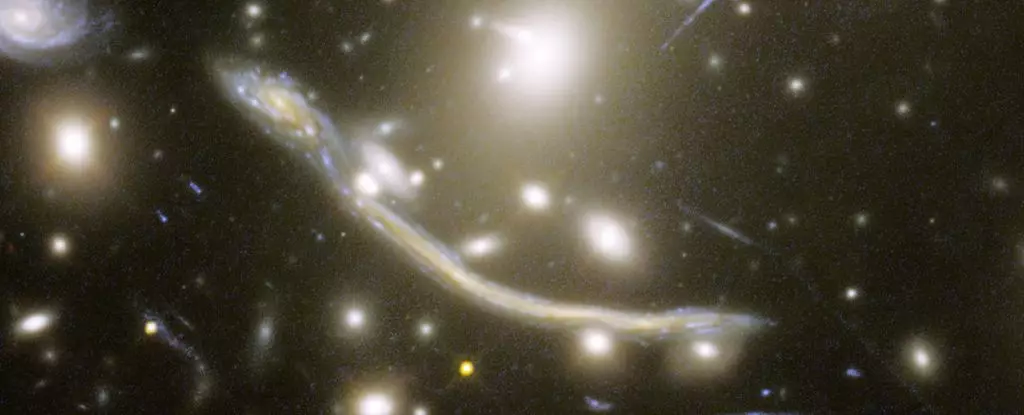The universe is a vast expanse of mystery, especially when it comes to observing the early stages of cosmic history. The light that bears witness to the existence of distant galaxies often requires billions of years to traverse the cosmos before being perceived by our instruments. With the introduction of groundbreaking technology like the James Webb Space Telescope (JWST), scientists are now able to pierce through the veil of space-time, illuminating aspects of the universe previously thought unattainable.
For centuries, astronomers have remained constrained by the limitations of their observational capabilities. The challenge of detecting individual stars, especially those from the early universe, has long plagued this field. The JWST has significantly advanced our understanding by resolving more than 40 distinct stars within a distant galaxy’s boundary—a feat that aligns with light that has traveled an astonishing 6.5 billion years to reach us. According to astrophysicist Fengwu Sun from the University of Arizona, this technological leap enables astronomers to study large populations of stars in distant galaxies, marking a pivotal moment in the field of astrophysics.
Historically, instruments like the Hubble Space Telescope managed to glimpse only a handful of stars in such distant locales, barely scratching the surface of the cosmos’s complexities. The success of JWST not only enhances what we can observe but also offers deeper insights, particularly regarding dark matter’s role within galaxy structures. With many individual stars now resolvable, we can begin to unfurl the intricate tapestry of the universe’s evolution.
A core aspect of JWST’s success lies in its utilization of gravitational lensing—a phenomenon explained by Einstein’s theory of general relativity. Massive celestial bodies, such as galaxy clusters, warp the fabric of space-time around them, similar to a heavy object distorting a soft surface. This distortion can amplify and distort the light from more distant objects, allowing astronomers to observe them in greater detail despite their extreme distance.
In one compelling case, a celestial feature known as the “Dragon Arc” sprawls across the night sky, appearing akin to a mythical creature. This arc represents multiple images of a distant spiral galaxy, elegantly formed as its light traverses the gravitational influence of a colossal cluster known as Abell 370, located roughly four billion light-years away. The intricate interplay between these gravitational forces reveals multiple images of the same galaxy, each distorted yet accessible to astronomers willing to reverse-engineer the effects of gravitational lensing.
Beyond the macro-lensing effects of large galaxy clusters, the universe also harbors rogue stars—lone entities moving independently between galaxies. Each of these stars can exert their slight lensing effects, termed microlensing. In a remarkable study led by Yoshinobu Fudamoto of Chiba University, researchers exploited this effect to resolve an impressive total of 44 individual stars within the Dragon Arc’s smeared light. Initially searching for a magnified background galaxy, the team stumbled upon these isolated stars, marking a significant milestone in astronomical research.
Sun emphasizes the importance of this discovery, noting that it’s the first time astronomers have recorded such a high number of individual stars from such a remote cosmic point. The implications of this finding are vast, expanding our understanding of star formation and galactic development in epochs far removed from our own.
Insights into Stellar Evolution
Among the stars identified in the Dragon Arc, many were observed to be red supergiants. These massive, cooler stars, nearing the conclusion of their life cycles, contrast markedly with the hotter, more luminous blue and white giants typically observed in deeper cosmic regions. The JWST’s ability to detect the infrared light emitted by red stars has opened new avenues for understanding stellar evolution.
This growing knowledge contributes to our broader comprehension of how galaxies have transformed through the ages. The dimness of red supergiants compared to their hotter counterparts makes them challenging to identify, yet JWST’s capabilities allow for an unprecedented look into their lives. Future observations promise even more revelations, shedding light on unseen cosmic phenomena lurking within the blurred boundaries of the Dragon Arc.
The exploration of distant galaxies and their stars is not merely a quest for knowledge; it serves as a crucial connection to our universe’s past. With innovative tools like the JWST, our reach into the depths of space-time grows ever more profound. Each discovery—be it an individual star or a galaxy—ushers in a new era of understanding about the universe’s intricate workings, ultimately enhancing our grasp of the cosmic story that unfolds over billions of years. The journey has just begun, and the stars await us.



Leave a Reply